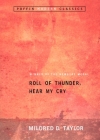 First up: 1977's Roll of Thunder, Hear My Cry. Holy cow, this book is great. I am going to make the bold claim that it's in fact a better kids' book about race relations than To Kill a Mockingbird. (Yes, TKaM is a kids' book.) The biggest reason for this? The little girl learning harsh truths about the racial injustice of the 1930s South is black herself. Scout may be troubled by what she learns about her world, but she can escape it as Cassie Logan never can.
First up: 1977's Roll of Thunder, Hear My Cry. Holy cow, this book is great. I am going to make the bold claim that it's in fact a better kids' book about race relations than To Kill a Mockingbird. (Yes, TKaM is a kids' book.) The biggest reason for this? The little girl learning harsh truths about the racial injustice of the 1930s South is black herself. Scout may be troubled by what she learns about her world, but she can escape it as Cassie Logan never can.Cassie is far luckier than many of her schoolmates, the children of tenant farmers--her grandfather managed to buy 400 acres of his own land, and the Logans farm for themselves, though her father still must spend months working on the railroad in Lousiana to pay taxes and the mortgage. Her mother is a teacher at the local black school, which runs only from October to March, since the students are needed to plant and harvest. The white school in the community, which hands down dilapidated, outdated textbooks when it feels like it, owns a school bus; every day the driver amuses his passengers by running Cassie and her brothers (one older, two younger) off the road, or splashing them with mud from puddles. These everyday humiliations, which they've learned to take in stride, are eventually eclipsed by far larger, darker acts of hatred.
Taylor's writing is just beautiful. I really think prose like hers is rare even in adult literature these days. Here, the first paragraph of Chapter 9:
Spring. It seeped unseen into the waiting red earth in early March, softening the hard ground for the coming plow and awakening life that had lain gently sleeping through the cold winter. But by the end of March it was evident everywhere: in the barn where three new calves bellowed and the chicks the color of soft pale sunlight chirped; in the yard where the wisteria and English dogwood bushes readied themselves for their annual Easter bloom, and the fig tree budded producing the forerunners of juicy, brown fruit for which the boys and I would have to do battle with fig-loving Jack; and in the smell of the earth itself. Rain-drenched, fresh, vital, full of life, spring enveloped all of us.LOOK at that long sentence: a colon and a semi-coloned list! Remember how The Hunger Games used nothing but commas? Taylor, quite the contrary, trusts ten-year-olds (like, you know, 1989 me) to figure out those little black specks and come away knowing new ways to put words together.
Another wonderful and brave thing about the book? No happy ending. Little is resolved, in fact, following a truly epic climax featuring a storm, an attempted lynching, and a cotton fire. Instead, Cassie cries, unable to unlearn what the year has taught her.
Wow.
(P.S. The copy I picked up at Housing Works, another 50-cent rack score, is a tie-in edition from a 1978 TV movie--with Morgan Freeman as dapper Uncle Hammer. Awesome.)
Sunday: 2002's A Single Shard by Linda Sue Park, set in a potters' village in 12th-century Korea.








No comments:
Post a Comment